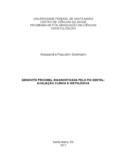| dc.creator | Grellmann, Alessandra Pascotini | |
| dc.date.accessioned | 2018-08-27T20:40:08Z | |
| dc.date.available | 2018-08-27T20:40:08Z | |
| dc.date.issued | 2017-12-11 | |
| dc.identifier.uri | http://repositorio.ufsm.br/handle/1/14110 | |
| dc.description.abstract | In the presence of contact point, dental floss detects more bleeding sites than
probing, possibly by greater contact with more inflamed internal part of papilla.
However, there is a lack of validation evidences. The aim of this thesis was to
validate the use of dental floss for the diagnosis of proximal gingivitis. After clinical
diagnosis with dental floss against gingiva (BF) followed by periodontal probe (GBI)
after 10 minutes, three subjects groups were identified: BF+/GBI+ bleeding papillae
with both methods (n=26); BF+/GBI- bleeding with dental floss, but non-bleeding with
probe (n=26); BF-/GBI- were non-bleeding with both methods (n=26). Subsequently,
one papilla of each adult participant, with no history of periodontitis, was biopsied and
histologically analyzed by a blind examiner. Inflammatory infiltrate analysis in gingival
conjunctive tissue (scores 0-3) and percentage of collagen fibers were performed.
Significantly higher frequencies of moderate/severe inflammation were observed in
BF+/GBI+ (100%) and BF+/GBI- (92.3%) groups compared to BF-/GBI- (0%) and
significantly different percentage of collagen fibers between three groups [BF+/GBI+
(40.90±3.68) BF+/GBI- (45.78±4.55) and BF-/GBI- (60.01±36.66)] (P<0.001). Also,
non-bleeding contralateral proximal sites with marginal probing (GBI-) and bleeding
(BF+) or not (BF-) with dental floss were identified in 49 subjects. After 24-48 hours,
volume of gingival crevicular fluid (VGCF) was collected with absorbent paper strips
and compared at test (BF+/GBI-) and control (BF-/GBI-) sites. From a total of 172
sites evaluated, test sites had a significantly higher VGCF (Periotron units) than
control sites (BF+ 38 [26.5–68] versus BF- 25 [15.7–51.25]; P<0,001, Wilcoxon test).
This difference was maintained for both anterior (BF+ 37 [23–66] versus BF- 21 [14–
45], P<0.001, Wilcoxon test) and posterior sites (BF+ 46 [28–92] versus BF- 34 [21–
70], P=0.04, Wilcoxon test). In absence of bleeding after probing, sites with flossing
bleeding present significantly greater inflammation than sites with no flossing
bleeding. Our results suggest flossing application as a diagnostic method for proximal
gingivitis in subjects with no periodontitis history. | eng |
| dc.description.sponsorship | Coordenação de Aperfeiçoamento de Pessoal de Nível Superior - CAPES | por |
| dc.language | por | por |
| dc.publisher | Universidade Federal de Santa Maria | por |
| dc.rights | Attribution-NonCommercial-NoDerivatives 4.0 International | * |
| dc.rights.uri | http://creativecommons.org/licenses/by-nc-nd/4.0/ | * |
| dc.subject | Doenças periodontais | por |
| dc.subject | Estudos de validação | por |
| dc.subject | Inflamação | por |
| dc.subject | Inflammation | eng |
| dc.subject | Periodontal diseases | eng |
| dc.subject | Periodontics | eng |
| dc.subject | Validation studies | eng |
| dc.title | Gengivite proximal diagnosticada pelo fio dental: avaliação clínica e histológica | por |
| dc.title.alternative | Proximal gingivitis diagnosed by dental floss: clinical and histological evaluation | eng |
| dc.type | Tese | por |
| dc.description.resumo | Na presença do ponto de contato, o fio dental detecta mais sítios sangrantes que a
sondagem, possivelmente pelo maior contato com a porção interna mais inflamada
da papila. Entretanto, faltam evidências de validação. O objetivo desta tese foi validar
o uso do fio dental para diagnóstico de gengivite proximal. Após diagnóstico clínico
com fio dental contra a gengiva (FG) seguido pela sonda periodontal (ISG) após 10
minutos, três grupos de sujeitos foram identificados: FG+/ISG+ papilas sangrantes
com ambos os métodos (n=26); FG+/ISG- sangrantes ao fio, mas não sangrantes à
sondagem (n=26); FG-/ISG- não sangrantes com ambos os métodos (n=26).
Posteriormente, uma papila de cada participante adulto, sem histórico de
periodontite, foi biopsiada e analisada histologicamente por um examinador cego.
Análise do infiltrado inflamatório no tecido conjuntivo gengival (escores 0-3) e
porcentagem de fibras colágenas foram realizadas. Frequências significativamente
maiores de inflamação moderada/severa foram observadas nos grupos FG+/ISG+
(100%) e FG+/ISG- (92,3%) em comparação ao FG-/ISG- (0%) e percentual de fibras
colágenas significativamente diferente entre os três grupos [FG+/ISG+ (40,903,68)
FG+/ISG- (45,784,55) e FG-/ISG- (60,013,66)] (P<0,001). Ainda, sítios proximais
contralaterais não sangrantes com sondagem marginal (ISG-) e sangrantes (FG+) ou
não (FG-) com fio dental foram identificados em 49 sujeitos. Após 24-48 horas, o
volume de fluido crevicular gengival (VFCG) foi coletado com tiras de papel
absorvente e comparado nos sítios teste (FG+/ISG-) e controle (FG-/ISG-). De um
total de 172 sítios avaliados, sítios teste apresentaram um VFCG (unidades de
Periotron) significativamente maior que sítios controle (FG+ 38 [26,5–68] versus FG-
25 [15,7–51,25]; P<0,001, teste Wilcoxon). Esta diferença se manteve tanto para
sítios anteriores (FG+ 37 [23–66] versus FG- 21 [14–45]; P<0,001, teste Wilcoxon)
como para sítios posteriores (FG+ 46 [28–92] versus FG- 34 [21–70]; P=0,04, teste
Wilcoxon). Na ausência de sangramento após sondagem, sítios com sangramento
ao fio dental apresentam inflamação significativamente maior que sítios sem
sangramento ao fio. Nossos resultados sugerem a utilização do fio dental como
método de diagnóstico de gengivite proximal em indivíduos sem histórico de
periodontite. | por |
| dc.contributor.advisor1 | Zanatta, Fabricio Batistin | |
| dc.contributor.advisor1Lattes | http://lattes.cnpq.br/0682875622264684 | por |
| dc.contributor.referee1 | Maraschin, Bruna Jalfim | |
| dc.contributor.referee1Lattes | http://lattes.cnpq.br/0849775379340729 | por |
| dc.contributor.referee2 | Moreira, Carlos Heitor Cunha | |
| dc.contributor.referee2Lattes | http://lattes.cnpq.br/4665807055028954 | por |
| dc.contributor.referee3 | Kantorski, Karla Zanini | |
| dc.contributor.referee3Lattes | http://lattes.cnpq.br/9045954332136714 | por |
| dc.contributor.referee4 | Angst, Patrícia Daniela Melchiors | |
| dc.contributor.referee4Lattes | http://lattes.cnpq.br/4153879209830089 | por |
| dc.creator.Lattes | http://lattes.cnpq.br/2680179057782062 | por |
| dc.publisher.country | Brasil | por |
| dc.publisher.department | Odontologia | por |
| dc.publisher.initials | UFSM | por |
| dc.publisher.program | Programa de Pós-Graduação em Ciências Odontológicas | por |
| dc.subject.cnpq | CNPQ::CIENCIAS DA SAUDE::ODONTOLOGIA | por |
| dc.publisher.unidade | Centro de Ciências da Saúde | por |



